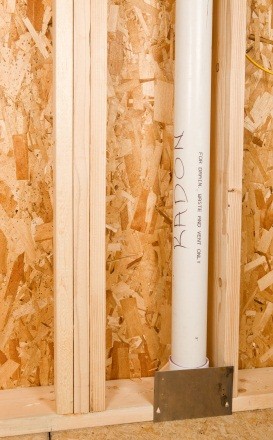
Homes with high levels of radon have been found in all Massachusetts counties, New Hampshire, and Rhode Island.
Most Massachusetts areas have moderate to high radon levels, with Middlesex, Essex and Worcester counties having the most incidences of high radon levels as determined by the Environment Protection Agency (EPA). One in four homes in Rhode Island contain radon at or above the Environmental Protection Agency action level of 4.0 pCi/L, a rate significantly higher than the national average of one in fifteen homes. In general, communities in southeastern and eastern New Hampshire have the highest percentage of homes with elevated radon levels. Rockingham, Carroll and Coos counties have several communities in which more than half of the homes tested had elevated radon.
 The EPA, Surgeon General and Massachusetts Department of Public Health urge all homeowners and home buyers to test for radon regardless of which county they reside in, because radon levels cannot be predicted and nearly 1 in 15 homes has an elevated radon level. This of particular concern, because the Surgeon General’s health advisory states that “radon gas is the second-leading cause of lung cancer in the United States.”
The EPA, Surgeon General and Massachusetts Department of Public Health urge all homeowners and home buyers to test for radon regardless of which county they reside in, because radon levels cannot be predicted and nearly 1 in 15 homes has an elevated radon level. This of particular concern, because the Surgeon General’s health advisory states that “radon gas is the second-leading cause of lung cancer in the United States.”
Still many homeowners and home buyers are unsure of whether they need to test for radon. This is often due to a lack of knowledge about what radon is and how it becomes a risk.
Radon is a radioactive gas that occurs naturally with the breakdown of radium and uranium in soil and rock. Since radon is a gas, it easily works its way out of the ground and into homes through foundation crack and holes. It can move into any space that allows for some air flow. Even new homes that are well-sealed and houses without basements are at risk. Radon can even dissolve into a home’s water, allowing the release of radon gas through running water.
Once radon enters an enclosed space like a home, it accumulates over time and radon levels can become elevated. With time radon also continues to decay further into radon daughters, which are solids and cling to the surfaces of things such as dust. When contaminated dust is inhaled, radon daughters can stick to the inside of the lungs, damaging lung tissue and thus increasing the risk of lung cancer.
Since radon is colorless, odorless, tasteless, and otherwise undetectable by human senses, it must be tested for. Most radon testing is done by home inspectors, but homeowners should not wait until they sell to test their home for radon. There are many companies in Massachusetts and New Hampshire that specialize in radon testing and mitigation. Do-it-yourself home testing kits are also available for as little as $10 for short-term testing (2 to 90 days) and as little as $50 for long-term testing (over 90 days).
On its website, the EPA provides do-it-yourselfers with a testing checklist to ensure accurate procedures and readings. In addition, the EPA provides a comparison of short and long-term tests to help consumers decide which radon testing kit is best. It does strongly encourage long-term testing. When buying a house home inspectors typically use a testing kit that sits in the home for about 48 hours.
If an elevated radon level is found, there are two ways to mitigate it. One, a homeowner can increase his home’s air exchange with various ventilation elements and permeable materials. Two, a homeowner can prevent radon entrance with caulking and sealing techniques directed at below-grade openings in the home’s foundation. Neither Massachusetts, New Hampshire, Rhode Island, nor the federal government regulate naturally occurring radon or radon daughters, but the EPA does offer specific recommended guidelines for homeowners and builders who seek to mitigate high radon levels.
For home buyers and homeowners who need more information about radon or who worry about the cost of mitigation, which can vary from a few hundred to a few thousand dollars, assistance programs are available. The Massachusetts’ Radiation Control Program’s Radon Unit provides information and financial assistance to homeowners that need radon testing and mitigation.
Home Buyer Resources
First-time Home Buyer Programs

Client: Kailee C.
"I really valued the level of professionalism and reliability that [he] consistently maintained. Further, I appreciated the timely manner in which he responded to my questions ..."
Client: Oksana P.
"No pressure approach made the process much easier ... in spite of an aggressive moving timeline."
Client: Geneva R.
"The service Buyers Brokers Only, LLC provided was truly invaluable to us in finding our first home. We couldn't be happier!"
Client: Mark V. & Laura V.
"It was an absolute pleasure to work with ... Buyers Brokers Only, LLC. There is absolutely no reason to use anyone else."

Call / Text (978) 835-5906